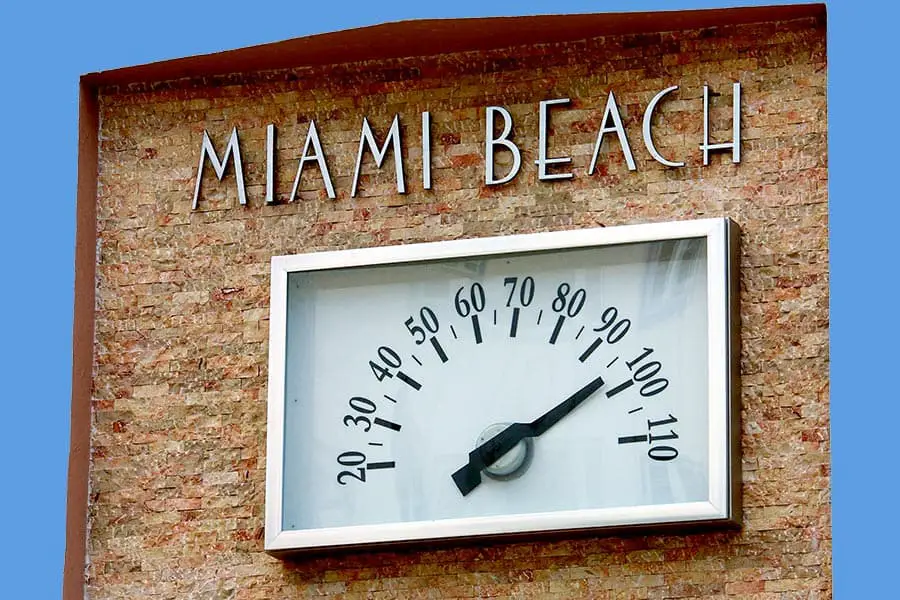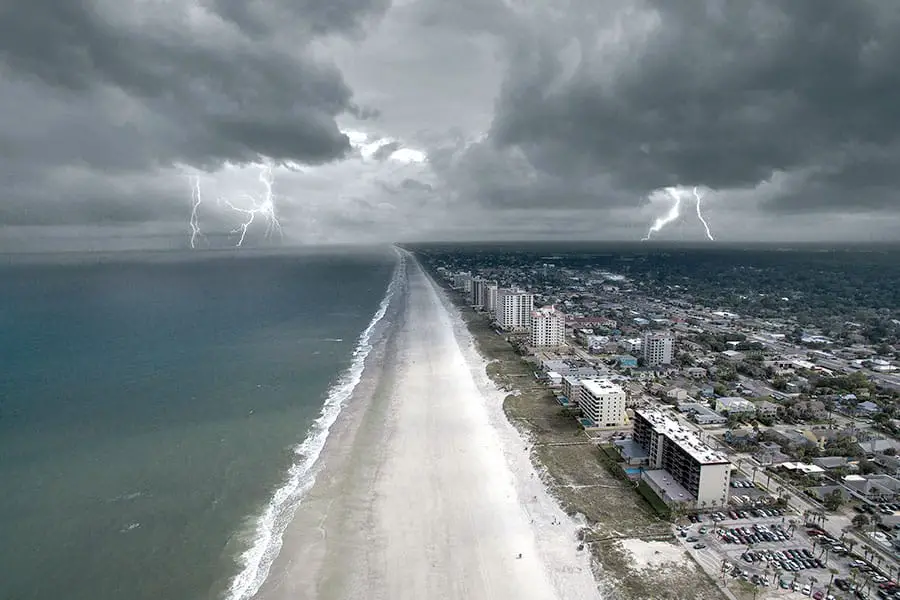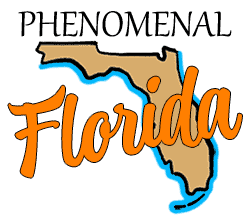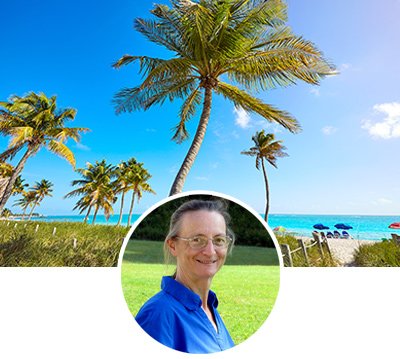
Florida is well known for being sunny and warm. In fact, many people visit or move to Florida just to enjoy the warmth of the Sunshine State. This makes us wonder, which of Florida’s coasts is warmer – is it Florida’s Atlantic east coast or her beautiful western Gulf coast?
Florida’s east coast is slightly warmer than the west coast. However, the difference is pretty small, and you’re likely to be nice and warm most anywhere in the Sunshine State. Major east-coast cities, particularly Miami, have a reputation for being nice and warm, and our data corroborates those claims.
But surely there’s more than that. Does the weather vary by season? What about the humidity? Is there a big difference between the weather on Florida’s east coast and west coast? Read on to learn more.
Which Florida Coast is Warmer?
To figure out which Florida coast is warmer, let’s examine the weather patterns in a few strategically located Florida cities that are close in latitude. We’ll check out Jacksonville, Daytona Beach, West Palm Beach, and Miami to get a feel for the weather on Florida’s east coast. We’ll examine Panama City, Cedar Key, Fort Myers, and Marco Island on the west coast.
We’ll also break down the weather by season – Florida’s winters are mild, but her summers can be a skosh on the hot side. The transitional seasons of spring and autumn sometimes blend in with summer and winter, but we will include them in the breakdown.
Generally speaking, Florida’s weather is dominated by a dryer, cooler winter season, and a warmer, wetter summer season. Okay, let’s check the weather.
Spring
Average Daily High:
| March | April | May | |
|---|---|---|---|
| Jacksonville (East) | 74 | 80 | 87 |
| Panama City (West) | 72 | 78 | 84 |
| Daytona Beach (East) | 74 | 79 | 85 |
| Cedar Key (West) | 77 | 82 | 88 |
| West Palm Beach (East) | 79 | 82 | 86 |
| Fort Myers (West) | 80 | 85 | 89 |
| Miami (East) | 80 | 83 | 87 |
| Marco Island (West) | 75 | 78 | 83 |
Warmest Coast in Spring: East Coast
In the springtime months of March, April, and May, the average temperature on Florida’s east coast is a balmy 81.3 degrees. On the west coast, the temperature in spring averages 80.9 degrees – very close indeed, but this match goes to the east coast.
Summer
Average Daily High:
| June | July | August | |
|---|---|---|---|
| Jacksonville (East) | 90 | 92 | 92 |
| Panama City (West) | 89 | 90 | 90 |
| Daytona Beach (East) | 88 | 90 | 90 |
| Cedar Key (West) | 91 | 92 | 92 |
| West Palm Beach (East) | 88 | 90 | 90 |
| Fort Myers (West) | 92 | 92 | 92 |
| Miami (East) | 89 | 91 | 91 |
| Marco Island (West) | 86 | 88 | 88 |
Warmest Coast in Summer: Tie
The Florida heat is on for the east coast, which averages about 90.1 degrees during the summer months. Coincidentally, the west coast also averages 90.1 degrees! So it’s fair to say that both coasts of Florida offer plentiful heat during the summer months.

Phenomenal Florida Fun Fact: The highest temperature ever recorded in Florida was on June 29, 1931, in the city of Monticello. It was 109 degrees Fahrenheit – phew!
Other Posts of Interest
- Which Florida Coast Is Better for Fishing? And The Species You Can Catch
- Are There Sharks In Tampa Bay?
- Do Both Alligators And Crocodiles Live In Florida?
- Is Florida A Good Place To Live For Retirees? Is It Tax-Friendly?
Autumn
Average Daily High:
| Sept. | Oct. | Nov. | |
|---|---|---|---|
| Jacksonville (East) | 88 | 81 | 74 |
| Panama City (West) | 88 | 81 | 73 |
| Daytona Beach (East) | 87 | 82 | 76 |
| Cedar Key (West) | 90 | 84 | 76 |
| West Palm Beach (East) | 88 | 85 | 80 |
| Fort Myers (West) | 91 | 87 | 81 |
| Miami (East) | 89 | 86 | 82 |
| Marco Island (West) | 87 | 83 | 78 |
Warmest Coast in Autumn: Tie
Summer’s oven-like heat begins to cool in the early autumn, but lovers of warmth will still find the 83.2 degree average on Florida’s east coast to be quite pleasant. And by an interesting coincidence, the west coast also enjoys an average of 83.25 degrees during autumn – but 0.05 degrees is insignificant, so we’ll call this one a tie too.
Winter
Average Daily High:
| Dec. | Jan. | Feb. | |
|---|---|---|---|
| Jacksonville (East) | 67 | 65 | 69 |
| Panama City (West) | 65 | 63 | 66 |
| Daytona Beach (East) | 70 | 68 | 71 |
| Cedar Key (West) | 70 | 69 | 71 |
| West Palm Beach (East) | 76 | 75 | 76 |
| Fort Myers (West) | 77 | 75 | 77 |
| Miami (East) | 78 | 76 | 78 |
| Marco Island (West) | 73 | 71 | 73 |
Warmest Coast in Winter: East Coast
Winter in Florida has a reputation for being pleasant and warm, and our data bears that out: Santa can wear a tropical shirt here instead of his fur-lined coat. The eastern seaboard of Florida enjoys a very mild winter with temperatures averaging 71.25 degrees, while the western seaboard clocks a slightly cooler 70.8 degrees. So if you want to maximize your warmth in Florida, the east coast winter is ever so slightly warmer.
The North-South Question
So far, our data shows that the east coast of Florida is ever so slightly warmer than the west coast of Florida. But is there a difference along a north-south division of the state? For example, are you warmer in Miami than you are in Panama City? We crunched the numbers, so you don’t have to:
| Spring | Summer | Autumn | Winter | |
|---|---|---|---|---|
| North | 80 | 90 | 82 | 67 |
| South | 82 | 89 | 84 | 75 |
Unsurprisingly, South Florida’s proximity to the equator helps keep her nice and toasty compared to north Florida.
Why is The East Coast of Florida Warmer Than The West Coast?
The east coast of Florida is part of the Gulf Stream. This warm current flows roughly northeastward, bringing warmer water and warmer air along with it. This is the most likely explanation of the temperature differential between the two coasts of Florida.

How Can You Beat the Heat in Florida?
In a hot place like Florida, it’s critical to prevent your body from overheating. One thing to do is to be aware of the heat index. The heat index is a calculation involving temperature and humidity that produces the “feels like” temperature you may see in your weather app. Even on a less warm day, humidity can make our bodies feel hotter than it is.
It is also essential to stay hydrated! Consume plenty of water throughout the day, even if you also drink things like coffee or soda. Stay out of direct sunlight for long times and take breaks in the air conditioning when you can.
Is Florida Humid?
While some places have a “dry heat,” Florida sticks out into the ocean and is surrounded on three sides by water, and this means that Florida can indeed get rather humid sometimes. In fact, Florida is the most humid state in the nation! Summer in Florida can be extra humid, especially near the coastline, but one can expect humidity anywhere in Florida.
North Florida tends to be less humid than south Florida, especially during the winter. People who find the humidity uncomfortable may wish to journey to north Florida for the summer months, where it is a little drier.
Is it Rainy in Florida?
Florida gets about fifty inches of rain a year, mainly during the summer season. The extra heat evaporates water from the ocean, and the heat and humidity combine to generate big, puffy clouds. Rainstorms in Florida are usually pretty quick; it is uncommon to get prolonged periods of drizzle. Floridians like to get their rainstorms over with so they can get back to the sunshine.

Does Florida ever get Thunderstorms?
Rainstorms are not uncommon, but there is a difference between rainstorms and thunderstorms. Thunderstorms are big, powerful storm systems that develop in the presence of warm air and humidity. During the summer months, it is not uncommon to experience several thunderstorms a week. These storms will bluster, flash, and boom for half an hour or so before they eventually lose steam and move along.
That said, thunderstorms can become violent, or have locally severe conditions within a violent storm. In addition, microbursts and even tornadoes occasionally spawn from thunderstorms, and powerful storm lines sometimes cause minor damage. That said, a good thunderstorm is an amazing and beautiful thing. And when the storm has expended itself, the sun generally breaks back through.
What Is The Best Season in Florida?
Let’s be honest – all of the seasons are great in Florida. If you’re looking to maximize the heat, you’ll find summers in Florida to your liking. If you like it a little cooler, you’ll enjoy the winter months. In this author’s opinion, winter in Florida is the best: warm but not too warm, cooler in the evenings, beautiful sunsets, and less humidity in the air make winter in Florida an absolute delight.
East and west Florida both have their own appeal. East Floridian cities like Daytona Beach and Miami are notorious vacation hotspots that boast beautiful beaches and plentiful entertainment. West Floridian cities like Marco Island and Panama City are also, coincidentally, well-known vacation hotspots with beautiful beaches and ample entertainment. So while the east coast of Florida may be a little warmer than the west coast, no matter where you go in Florida, you’re sure to have a great time.





